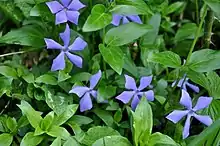| Vinca herbacea | |
|---|---|
 | |
| Vinca herbacea leaves and flowers | |
| Scientific classification | |
| Kingdom: | Plantae |
| Clade: | Tracheophytes |
| Clade: | Angiosperms |
| Clade: | Eudicots |
| Clade: | Asterids |
| Order: | Gentianales |
| Family: | Apocynaceae |
| Genus: | Vinca |
| Species: | V. herbacea |
| Binomial name | |
| Vinca herbacea | |
| Synonyms[1] | |
| |
Vinca herbacea, with common name herbaceous periwinkle, is a flowering plant native to eastern and southeastern Europe, from Austria south to Greece, and east to the Crimea, and also in northern Western Asia, in the Caucasus and Alborz mountains.
It grows mainly in steppe habitats.
Description
Vinca herbacea is a herbaceous perennial growing as a trailing vine, spreading along the ground and rooting along the stems to form clonal colonies, growing up to 10–20 centimetres (3.9–7.9 in) high.
The leaves are opposite, lanceolate, 1–5 centimetres (0.39–1.97 in) long and 0.2–3 centimetres (0.079–1.181 in) broad, glossy green with an entire margin, and nearly sessile with only a very short petiole.
The flowers are produced in late summer, blue-violet or occasionally white, 2.5–3.5 centimetres (0.98–1.38 in) diameter, with a five-lobed corolla.
Cultivation
Vinca herbacea is occasionally grown as an ornamental plant in temperate climate gardens, as a rock garden plant.
References
Further reading
- Huxley, A., ed. (1992). New RHS Dictionary of Gardening 4: 664–665. Macmillan.